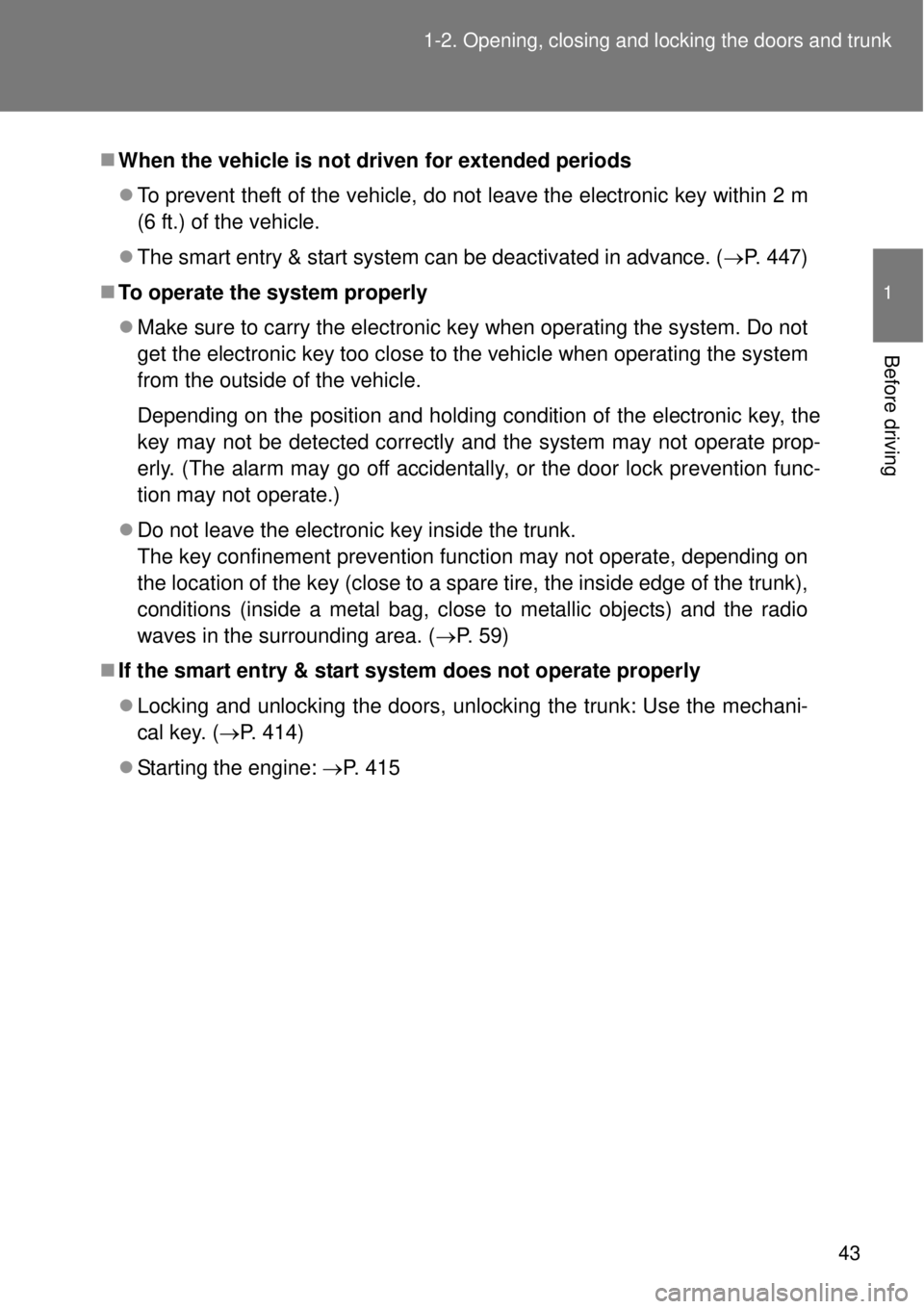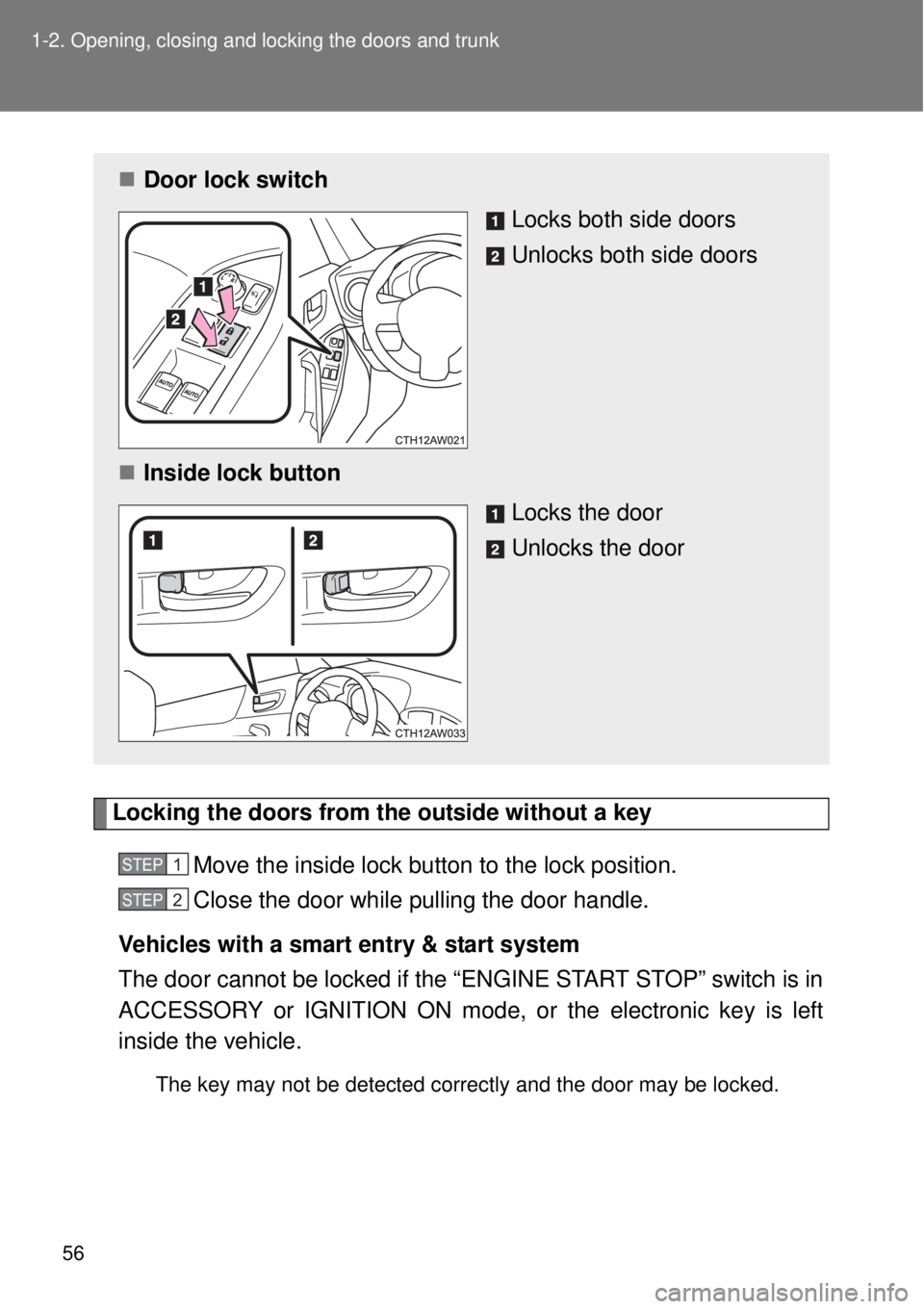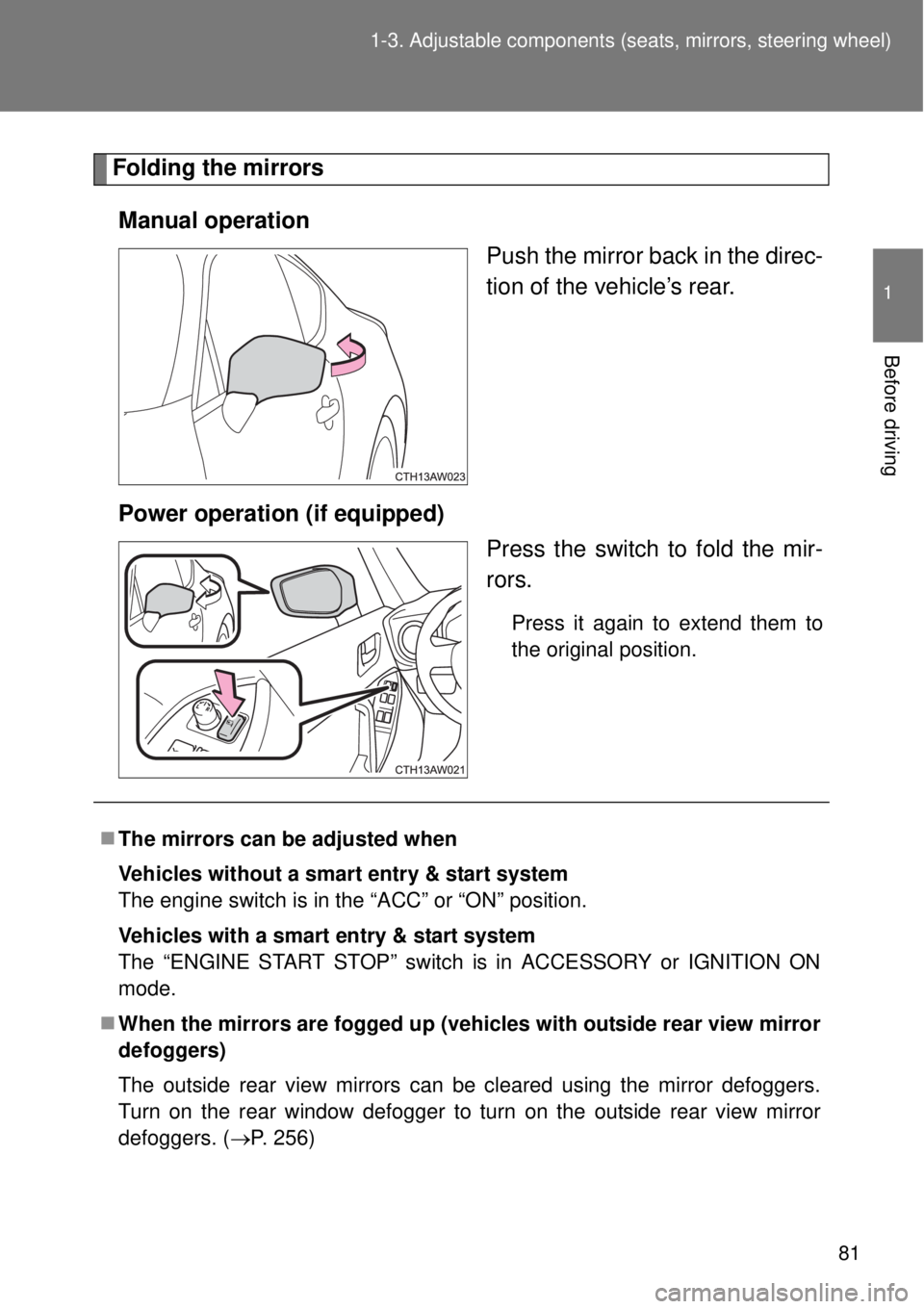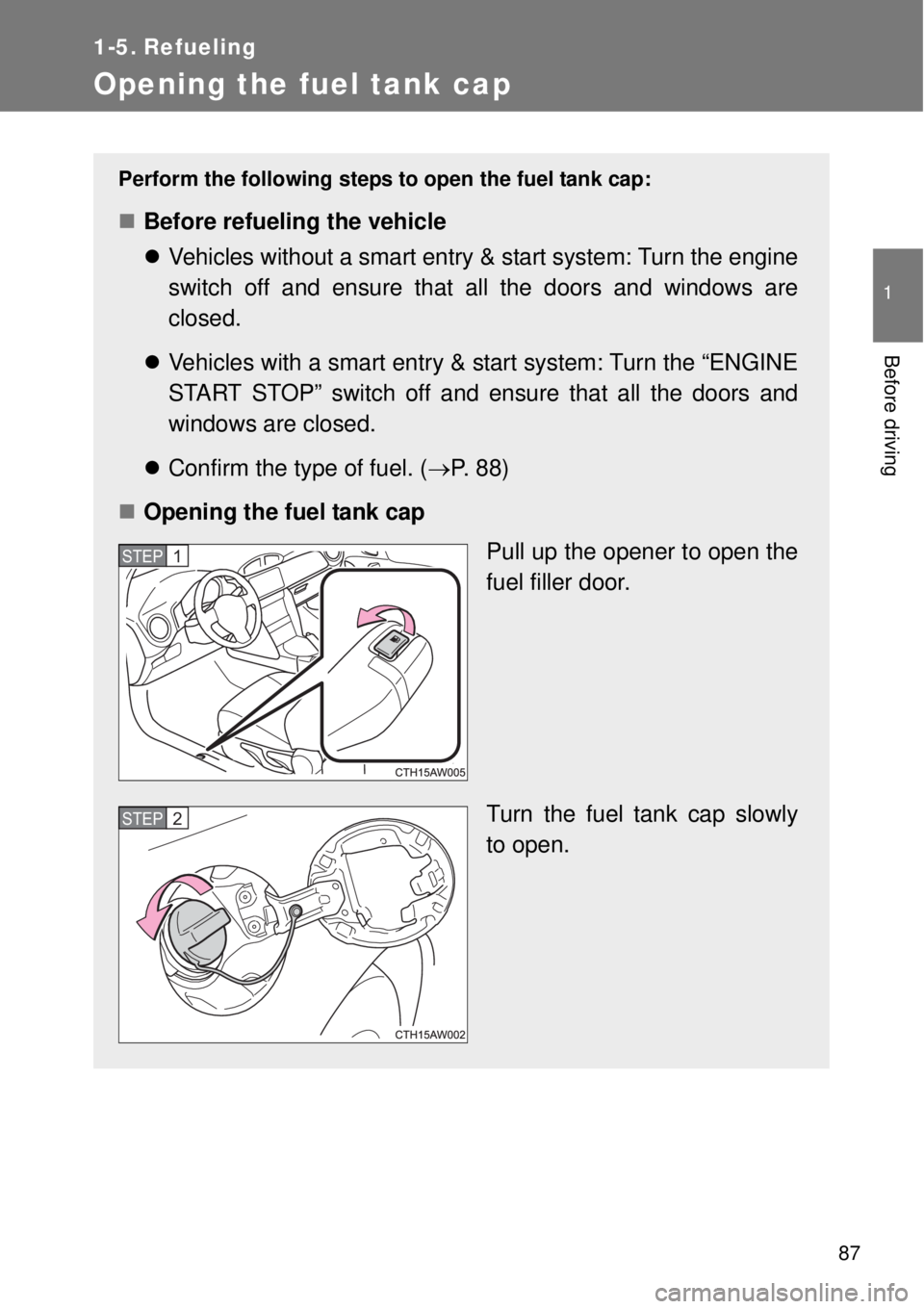engine TOYOTA GT86 2015 (in English) User Guide
[x] Cancel search | Manufacturer: TOYOTA, Model Year: 2015, Model line: GT86, Model: TOYOTA GT86 2015Pages: 464, PDF Size: 10.65 MB
Page 40 of 464

40 1-2. Opening, closing and locking the doors and trunk
Conditions affecting operation
The smart entry & start system uses weak radio waves. In the following situ-
ations, the communication between the electronic key and the vehicle may
be affected, preventing the smart entry & start system, wireless remote con-
trol and engine immobilizer system from operating properly.
(Way of coping P. 414)
When the electronic key battery is depleted
Near a TV tower, electric power plant, gas station, radio station, large dis-
play, airport or other facility that generates strong radio waves or electri-
cal noise
When the electronic key is in contact with, or is covered by the following
metallic objects
• Cards to which aluminum foil is attached
• Cigarette boxes that have aluminum foil inside
• Metallic wallets or bags
• Coins
• Hand warmers made of metal
• Media such as CDs and DVDs
When other wireless key (that emit radio waves) is being used nearby
When carrying the electronic key together with the following devices that
emit radio waves
• A portable radio, cellular phone, cordless phone or other wireless com-
munication device
• Another vehicle's electronic key or a wireless key that emits radio
waves
• Personal computers or personal digital assistants (PDAs)
• Digital audio players
• Portable game systems
If window tint with a metallic content or metallic objects are attached to
the rear window
When the electronic key is placed near a battery charger or electronic
devices
Page 41 of 464

41 1-2. Opening, closing and locking the doors and trunk
1
Before driving
Notes for the entry function
Even when the electronic key is within the effective range (detection
areas), the system may not operate properly in the following cases:
• The electronic key is too close to the window or outside door handle,
near the ground, or in a high place when the doors are locked or
unlocked.
• The electronic key is near the ground or in a high place, or too close to
the rear bumper center when the trunk is unlocked.
• The electronic key is on the instrument panel, rear package tray or
floor, in the door pockets or glove box or auxiliary box when the engine
is started or “ENGINE START STOP” switch modes are changed.
Do not leave the electronic key on top of the instrument panel or near the
door pockets when exiting the vehicle. Depending on the radio wave
reception conditions, it may be detected by the antenna outside the cabin
and the door will become lockable from the outside, possibly trapping the
electronic key inside the vehicle.
As long as the electronic key is within the effective range, the doors may
be locked or unlocked by anyone.
Even if the electronic key is not inside the vehicle, it may be possible to
start the engine if the electronic key is near the window.
The doors may unlock if a large amount of water splashes on the door
handle, such as in the rain or in a car wash when the electronic key is
within the effective range. (The door will automatically be locked after
approximately 30 seconds if the doors are not opened and closed.)
Gripping the door handle when wearing a glove may not unlock the door.
If the wireless remote control is used to lock the doors when the elec-
tronic key is near the vehicle, there is a possibility that the door may not
be unlocked by the entry function. (Use the wireless remote control to
unlock the doors.)
A sudden approach to the effective range or door handle may prevent the
doors from being unlocked. In this case, return the door handle to the
original position and check that the doors unlock before pulling the door
handle again.
Page 43 of 464

43 1-2. Opening, closing and locking the doors and trunk
1
Before driving
When the vehicle is not driven for extended periods
To prevent theft of the vehicle, do not leave the electronic key within 2 m
(6 ft.) of the vehicle.
The smart entry & start system can be deactivated in advance. (P. 447)
To operate the system properly
Make sure to carry the electronic key when operating the system. Do not
get the electronic key too close to the vehicle when operating the system
from the outside of the vehicle.
Depending on the position and holding condition of the electronic key, the
key may not be detected correctly and the system may not operate prop-
erly. (The alarm may go off accidentally, or the door lock prevention func-
tion may not operate.)
Do not leave the electronic key inside the trunk.
The key confinement prevention function may not operate, depending on
the location of the key (close to a spare tire, the inside edge of the trunk),
conditions (inside a metal bag, close to metallic objects) and the radio
waves in the surrounding area. (P. 59)
If the smart entry & start system does not operate properly
Locking and unlocking the doors, unlocking the trunk: Use the mechani-
cal key. (P. 414)
Starting the engine:P. 415
Page 44 of 464

44 1-2. Opening, closing and locking the doors and trunk
Electronic key battery depletion
The standard battery life is 1 to 2 years.
If the battery becomes low, an alarm will sound in the cabin when the
engine stops. (P. 380)
As the electronic key always receives radio waves, the battery will
become depleted even if the electronic key is not used. The following
symptoms indicate that the electronic key battery may be depleted.
Replace the battery when necessary. (P. 331)
• The smart entry & start system or the wireless remote control does not
operate.
• The detection area becomes smaller.
• The LED indicator on the key surface does not turn on.
To avoid serious deterioration, do not leave the electronic key close to
any of the following electrical appliances that produce a magnetic field:
•TVs
• Personal computers
• Cellular phones, cordless phones and battery chargers
• Recharging cellular phones or cordless phones
• Induction cookers
• Table lamps
When the electronic key battery is fully depleted
P. 331
If the smart entry & start system has been deactivated in a customized
setting
Locking and unlocking the doors, unlocking the trunk: Use the wireless
remote control or mechanical key. (P. 51, 414)
Starting the engine and changing “ENGINE START STOP” switch
modes: P. 415
Stopping the engine: P. 417
Customization that can be configured at any authorized Toyota dealer
or repairer, or another duly qualified and equipped professional
Settings (e. g. smart entry & start system) can be changed.
(Customizable features: P. 447)
Page 56 of 464

56 1-2. Opening, closing and locking the doors and trunk
Locking the doors from the outside without a key
Move the inside lock button to the lock position.
Close the door while pulling the door handle.
Vehicles with a smart entry & start system
The door cannot be locked if the “ENGINE START STOP” switch is in
ACCESSORY or IGNITION ON mode, or the electronic key is left
inside the vehicle.
The key may not be detected correctly and the door may be locked.
Door lock switch
Locks both side doors
Unlocks both side doors
Inside lock button
Locks the door
Unlocks the door
STEP 1
STEP 2
Page 81 of 464

81 1-3. Adjustable components (seats, mirrors, steering wheel)
1
Before driving
Folding the mirrors
Manual operation
Push the mirror back in the direc-
tion of the vehicle’s rear.
Power operation (if equipped)
Press the switch to fold the mir-
rors.
Press it again to extend them to
the original position.
The mirrors can be adjusted when
Vehicles without a smart entry & start system
The engine switch is in the “ACC” or “ON” position.
Vehicles with a smart entry & start system
The “ENGINE START STOP” switch is in ACCESSORY or IGNITION ON
mode.
When the mirrors are fogged up (vehicles with outside rear view mirror
defoggers)
The outside rear view mirrors can be cleared using the mirror defoggers.
Turn on the rear window defogger to turn on the outside rear view mirror
defoggers. (P. 256)
Page 84 of 464

84 1-4. Opening and closing the windows
The power windows can be operated when
Vehicles without a smart entry & start system
The engine switch is in the “ON” position.
Vehicles with a smart entry & start system
The “ENGINE START STOP” switch is in IGNITION ON mode.
Operating the power windows after turning the engine off
Vehicles without a smart entry & start system
The power windows can be operated for approximately 45 seconds even
after the engine switch is turned to the “ACC” or “LOCK” position. They can-
not, however, be operated once either door is opened.
Vehicles with a smart entry & start system
The power windows can be operated for approximately 45 seconds even
after the “ENGINE START STOP” switch is turned to ACCESSORY mode or
turned off. They cannot, however, be operated once either door is opened.
Jam protection function
If an object becomes caught between the window and the body, window
travel is stopped and the window is opened slightly.
Page 85 of 464

85 1-4. Opening and closing the windows
1
Before driving
When the power window does not close normally
If the jam protection function is operating abnormally and a window cannot
be closed, close all the doors and perform the following operations using the
power window switch on the relevant door.
Vehicles without a smart entry & start system: After stopping the
vehicle, the engine switch is turned to the “ON” position.
Vehicles with a smart entry & start system: After stopping the vehi-
cle, the “ENGINE START STOP” switch is turned to IGNITION ON
mode.
Hold the power window switch in the one-touch closing position two
consecutive times.
Hold the power window switch in the one-touch closing position
once again and continue holding for 1 second or more after the win-
dow closes completely.
If you push the power window switch to the opening position while the win-
dow is moving, start again from the beginning. If the window continues to
close but then re-open slightly even after performing the above procedure
correctly, have the vehicle inspected by any authorized Toyota dealer or
repairer, or another duly qualified and equipped professional.
STEP 1
STEP 2
STEP 3
Page 86 of 464

86 1-4. Opening and closing the windows
CAUTION
Closing the windows
Observe the following precautions.
Failure to do so may result in death or serious injury.
The driver is responsible for all the power window operations, including the
operation for the passengers. In order to prevent accidental operation,
especially by a child, do not let a child operate the power windows. It is
possible for children and other passengers to have body parts caught in
the power window. Also, when riding with a child, it is recommended to use
the window lock switch. (P. 83)
Check to make sure that all passengers do not have any part of their body
in a position where it could be caught when a window is being operated.
When exiting the vehicle, turn the engine switch (vehicles without a smart
entry & start system) or the “ENGINE START STOP” switch (vehicles with
a smart entry & start system) off, carry the key and exit the vehicle along
with the child. There may be accidental operation, due to mischief, etc.,
that may possibly lead to an accident.
Jam protection function
Never use any part of your body to intentionally activate the jam protection
function.
The jam protection function may not work if something gets caught just
before the window fully closes.
Page 87 of 464

87
1
Before driving
1-5. Refueling
Opening the fuel tank cap
Perform the following steps to open the fuel tank cap:
Before refueling the vehicle
Vehicles without a smart entry & start system: Turn the engine
switch off and ensure that all the doors and windows are
closed.
Vehicles with a smart entry & start system: Turn the “ENGINE
START STOP” switch off and ensure that all the doors and
windows are closed.
Confirm the type of fuel. (P. 8 8 )
Opening the fuel tank cap
Pull up the opener to open the
fuel filler door.
Turn the fuel tank cap slowly
to open.
STEP 1
STEP 2